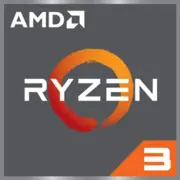AMD Ryzen 3 PRO 2200GE with Radeon Vega 8 Graphics

AMD Ryzen 3 PRO 2200GE with Radeon Vega 8 Graphics: Review and Practical Tips for Building in 2025
(Relevant as of April 2025)
Introduction
The AMD Ryzen 3 PRO 2200GE is a budget processor with integrated graphics, launched in 2018. Despite its age, it remains relevant for office systems, media centers, and basic PCs due to its low TDP and affordable price. In 2025, it can be found for about $80–100 (new). Let's explore who it is suitable for now and how to build an efficient system based on it.
1. Key Specifications: Architecture and Performance
Zen Architecture and 14nm Process Technology
The processor is built on the first generation Zen microarchitecture (codename "Raven Ridge") using 14nm FinFET. This provides a balance between energy efficiency and performance.
- Cores and Threads: 4 cores, 4 threads (no Hyper-Threading).
- Base/Max Clock Speed: 3.2 GHz / 3.6 GHz.
- Cache: L3 — 4 MB, L2 — 2 MB.
- Integrated Graphics: Radeon Vega 8 (8 GPU cores, clock speed 1100 MHz).
Performance in 2025
For basic tasks, the processor demonstrates sufficient speed:
- Office Applications (Word, Excel, browser with 10+ tabs) — operates without delays.
- Multimedia: 4K video (H.265) is hardware-decoded, but streaming 4K on YouTube requires at least 8 GB of RAM.
- Gaming: CS:GO — 50–60 FPS on low settings (720p), Dota 2 — 40–45 FPS (720p).
Key Features:
- Low power consumption (TDP 35W).
- Support for AMD SenseMI and Secure Processor technologies for data encryption.
2. Compatible Motherboards
AM4 Socket and Chipsets
The processor uses the AM4 socket, allowing the selection of motherboards from a wide range of models:
- Chipsets: A320, B450, X470.
- Recommendations:
- Budget Option: ASRock A320M-HDV (price: $50–60). Suitable for office PCs without overclocking.
- For Upgrade: Gigabyte B450M DS3H (price: $70–80). Supports PCIe 3.0 and memory overclocking.
Important: Before purchasing, check if the motherboard’s BIOS has been updated to a version that supports the Ryzen 2000 series.
3. Supported Memory
DDR4 Up to 2933 MHz
The processor works only with DDR4 (DDR5 is not supported).
- Recommended Modules:
- 2 × 4 GB DDR4-2666 MHz (minimum option for Windows 10/11).
- 2 × 8 GB DDR4-3200 MHz (optimal for gaming and multitasking).
Tip: Use dual-channel mode — this will boost Vega 8 performance by 15–20%.
4. Power Supply Recommendations
Power and Efficiency
Considering the TDP of 35W and the absence of a discrete graphics card:
- Minimum: 300W power supply (e.g., EVGA 300 W1, $35).
- With Headroom for Upgrades: 450–500W (Corsair CX450, $55).
Practical Example: A system with Ryzen 3 PRO 2200GE, SSD, 16 GB of RAM, and two HDDs consumes about 90–120W under load.
5. Pros and Cons of the Processor
Advantages:
- Energy efficiency: ideal for compact cases (e.g., InWin Chopin).
- Presence of Vega 8 — no need to purchase a graphics card for basic tasks.
- Support for modern interfaces: HDMI 2.0, NVMe (via chipset).
Disadvantages:
- 4 threads: limited multitasking (e.g., streaming on Twitch + gaming will cause lags).
- Outdated 14nm process technology (competitors on 7nm/6nm are more efficient).
- No support for PCIe 4.0.
6. Use Cases
Office and Studies
- Real Example: A PC for remote work with Microsoft Teams, Excel, and browser — functions well with 8 GB of RAM.
Multimedia
- Home Theater: Connecting to a 4K TV via HDMI, using streaming service Kodi.
Light Gaming
- 2025 Games: Inadequate for modern projects, but RetroArch and indie games (Hollow Knight, Stardew Valley) achieve 60 FPS.
7. Comparison with Competitors
AMD Ryzen 5 3400G
- Price: $120–140.
- Pros: 4 cores/8 threads, Vega 11, higher gaming performance.
- Conclusion: If the budget allows, the 3400G is preferable.
Intel Core i3-10100
- Price: $100–110.
- Pros: UHD Graphics 630, higher IPC.
- Cons: Integrated graphics are weaker than Vega 8.
8. Assembly Tips
Optimal Configuration
- Motherboard: Gigabyte B450M DS3H.
- Memory: 16 GB DDR4-3200 (TeamGroup Vulcan Z).
- Storage: NVMe SSD 512 GB (Kingston NV2, $35).
- Case: Cooler Master MasterBox Q300L (compact, good ventilation).
What to Avoid:
- Expensive X570 motherboards — not worth it due to the processor's limitations.
- Power supplies over 500W — excessive for a system without a discrete graphics card.
9. Final Conclusion: Who is the Ryzen 3 PRO 2200GE Suitable For?
This processor is worth choosing if:
1. Budget is limited ($250–350 for the entire build).
2. A quiet PC is needed for work, studies, or a media center.
3. Integrated graphics are required for light gaming.
Alternative: If you plan to upgrade in the future, it's better to choose the Ryzen 5 5600G (6 cores/12 threads, $150) — it supports PCIe 3.0 and DDR4-3200.
Conclusion
The Ryzen 3 PRO 2200GE in 2025 is a niche solution for those who value minimalism and low power consumption. It falls behind modern APUs in performance but remains relevant as a "workhorse" for basic tasks.
Basic
CPU Specifications
Memory Specifications
GPU Specifications
Miscellaneous
Benchmarks
Compared to Other CPU
Share in social media
Or Link To Us
<a href="https://cputronic.com/en/cpu/amd-ryzen-3-pro-2200ge-with-radeon-vega-8-graphics" target="_blank">AMD Ryzen 3 PRO 2200GE with Radeon Vega 8 Graphics</a>